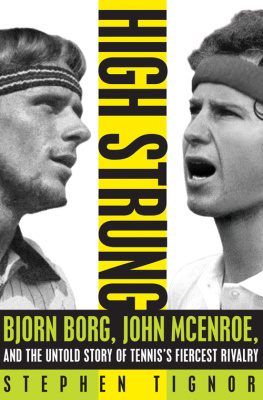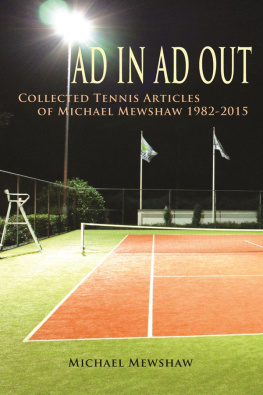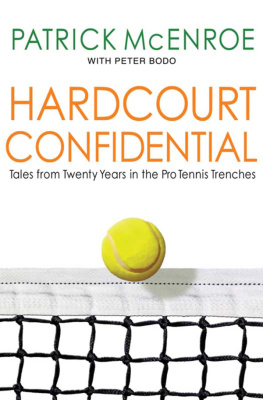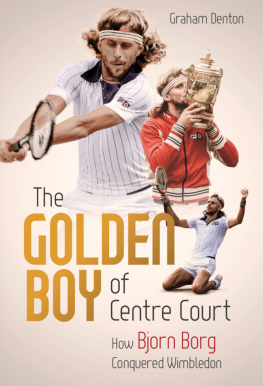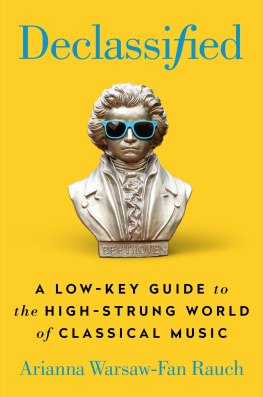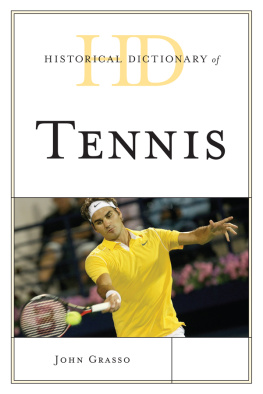HIGH STRUNG
Bjorn Borg, John McEnroe, and the Untold Story of Tenniss Fiercest Rivalry
Stephen Tignor

To the memory of my grandparents and first tennis teachers,
William and Anne P. Hamilton
Contents
The Angel and the Brat
Barbarians on the Lawns
The Next Victim
Lingering Death
The Dark Prince of Queens
Exile on Park Avenue
The Valley of Ashes
Tearing the Cover Off the Game
Taking Love on the Rise
Mr. Nasty
The Lord of Discipline
Fallen Angel
Nobody Beats Vitas Gerulaitis...
Ivan the Powerful
Heroes and Villains
Super Saturday
Requiem for an Assassin
THE ANGEL AND THE BRAT
Its what I live with, you know, that I lose someday.
BJORN BORG
I n the minds of most tennis fans, when Bjorn Borg took his first rolling, measured strides onto Centre Court for the 1980 Wimbledon final, he might have been stepping down from the clouds. The myth of the divine Swede had been growing in London since 1973, when hed made his debut as a 17-year-old. That year, Borgs wavy blond hair and shy, smooth-cheeked smile earned him the nickname Teen Angel. They also earned him the attention of hordes of shrieking, hopping, giggling, weeping, and uncontrollably aggressive English schoolgirls. After his first match, 300 of them attacked Borg and dragged him to the ground. Thus began a phenomenon previously unseen on the lawns of the All England Club, one that would take a variety of forms over the ensuing years: the Borgasm. (Asked later if hed been scared by the experience, Borg replied with the equanimity that would become his trademark: Well, yes, I was a little scared, as I lay there in the dust on the street with girls all over me. But it was fun, too.)
The following year, Wimbledon officials put out the word to 60 neighboring schools: Keep the girls under control. They couldnt do it, and neither could the police. The Viking God was mobbed, one club member reported in 1974, and in the scuffle a policemans helmet was knocked off and an officer knocked to the ground.
As the decade progressed and Borg evolved from a young heartthrob to a grizzled world champion, his myth and his nickname evolved with him. By 1980 he had been rechristened the Angelic Assassin. A silent man with a headband for a halo, Borg was renowned for his icy precision and improbable, back-from-the-brink victories. He was, by all appearances, invincible in the paramount test of tennis nerve, the five-set match. He had won 10 straight dating back to 1976. With his seemingly inhuman consistency and his impenetrable reserve on court, there was an air of mystery, of the uncanny, surrounding everything Borg did. Urban legends sprouted around him. His heart rate was 35 (it was between 50 and 60). He slept 10 hours a night in freezing cold hotel rooms (he did). His racquets were strung so tightly they popped in his hotel room while he was sleeping (they did). He had ice in his veins (probably not true). Fellow player Ilie Nastase referred to him as the Martian.
The mythmaking was understandable because Borg was one of those rare athletes who changed the nature of his sport single-handedlyor, in his case, double-handedly. For 30 years the accepted style of play in mens tennis had been to follow the serve forward, to attack, to pressure the opponent and create winning angles by hitting your shots from as close to the net as possible. It was known as the Big Game, and it seemed to be the final word in strategy. But Borg, legendary from a young age for his stubbornness, turned the textbookand the sports geometryupside down. Believing that the Big Game was as much about machismo as it was tactics, he stayed back, and won by outlasting his opponents. He hit his forehand with an extreme grip that had rarely been seen before, and he popularized the two-handed backhand, an equally rare shot before him, but one that would become virtually universal after him.
Borgs style elevated physicality and athleticism to a higher degree of importance in tennis. He kept his weight at 160 at all times and didnt worry much about his technique; what he cared about most was arriving at the ball in time to hit itand then never missing it. He was also a minimalist when it came to tactics. Asked how he approached an important point, Borg said he made sure I got the ball over the net. His game was taxing on mind and body, yet by the end of the 1970s his approach had wiped away three decades of the Big Game and established itself as the new orthodoxy.
No one could argue with its success: Borg entered the 1980 Wimbledon final having won four straight titles there, a record unmatched by any man in the 20th century. He was at the peak of his powers. A June 1980 Time cover story on Borg, which began by asking, Is he the greatest of all time?, called him an incredible tennis machine, an inexorable force that is one part speed, one part topspin, and two parts iron will. His victories werent merely inevitable. They seemed to be ordained from above.
So it might have come as a disappointment to many to find out that the Angelic Assassin, rather than descending from Valhalla, or Mars, or Big Bens tower, had ridden in for the final that day from a local Holiday Inn. Located next to the grass court club where he practiced in the Hampstead section of London, the hotel was where Borg always stayed during the tournament. It took 45 minutes by car to get to the All England Club, and Borg had made the trip the same way for the better part of four years. He rode up front in the passenger seat. His fiance, Mariana Simionescu, a Romanian tennis pro two years his senior who trimmed his hair and cooked his meals, sat in the back. Lennart Bergelin, his 55-year-old coach, who also served as his secretary, masseur, racquet keeper, and second father, was at the wheel. This three-person cocoonhome to Borghad been threading its peaceful way through the tennis world undisturbed since 1976.
The car was always a Saab, which was one of Borgs sponsors, and Bergelin always drove, for the same reason that he answered Borgs phone calls and kept his 50 racquets precisely tuned at all times: so his player wouldnt waste a moment of concentration on anything other than batting a tennis ball over a net. The route Bergelin took through Londons leafy suburbs never varied. It wasnt necessarily the shortest path, but it minimized the chance that Borg would be confronted with something new along the way.
Superstition is a guiding faith among professional tennis players. Theyll do whatever it takes not to step on a line as they walk around the court. In the midst of a winning streak, theyve been known to eat nothing but McDonalds or wear the same pair of shorts for 10 days running. But it was more than just an occupational hazard for Bjorn Borg; the trait ran in his family. His parents, Rune and Margarethe, first saw their son win at the All England Club in 1977. The last digit of that year was taken as a sign. From then on, they would attend Wimbledon only in odd-numbered years, while traveling to the French Open, which Borg would eventually win six times, in even-numbered years. As of 1980, their record was unblemished, though there had been more than a few close calls.
In the 1979 Wimbledon final, Borg played an intense five-set match with Roscoe Tanner, an American whose erratic, go-for-broke style and machine-gun lefty serve always rattled him. Margarethe ate candy throughout the match, for luck, as she did during many of her sons matches. After more than three hours, Borg served for the title at 5-4 in the fifth set. He went up 40-0, triple match point. His mother thought she was safe at last, so she spit the well-chewed candy on the floor of the players guest box. Borg proceeded to lose the next three points. Margarethe picked up the candy and popped it back in her mouth. Borg won the next two points and the match.
Next page
